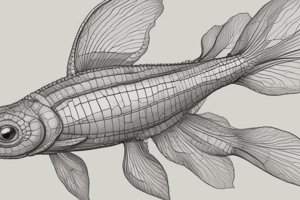Podcast
Questions and Answers
Che cos'è il ciclo biologico?
Che cos'è il ciclo biologico?
- Il processo di riproduzione degli organismi.
- Il ciclo di vita degli organismi, comprese le fasi di crescita e sviluppo. (correct)
- Un metodo di coltivazione delle piante.
- L'insieme delle interazioni tra specie in un ecosistema.
Che cos'è l'ontogenesi?
Che cos'è l'ontogenesi?
- La formazione di un nuovo individuo a partire da una cellula iniziale tramite divisioni cellulari
- Il processo di evoluzione delle specie nel tempo.
- L'interazione tra organismi diversi in un ecosistema.
- . La formazione di un nuovo individuo a partire da una cellula iniziale tramite divisioni cellulari (correct)
Quali sono gli stadi del ciclo biologico? (Seleziona tutte le opzioni corrette)
Quali sono gli stadi del ciclo biologico? (Seleziona tutte le opzioni corrette)
- Fase di crescita
- Fase di riproduzione
- Uovo, zigote, embrione, stadi giovanili, stadio adulto (correct)
- Fase di inattività
Che cos'è l'embriogenesi?
Che cos'è l'embriogenesi?
Quali sono i tipi di uova in base alla quantità di tuorlo?
Quali sono i tipi di uova in base alla quantità di tuorlo?
Che cos'è la fecondazione esterna?
Che cos'è la fecondazione esterna?
Quali sono i principali tipi di fecondazione?
Quali sono i principali tipi di fecondazione?
Che cos'è la segmentazione?
Che cos'è la segmentazione?
Quali sono i tipi di segmentazione? (Seleziona tutte le opzioni corrette)
Quali sono i tipi di segmentazione? (Seleziona tutte le opzioni corrette)
Che cos'è la gastrulazione?
Che cos'è la gastrulazione?
Quali sono i foglietti germinativi?
Quali sono i foglietti germinativi?
Che cos'è una gastrula?
Che cos'è una gastrula?
Quali sono gli organismi diblastici?
Quali sono gli organismi diblastici?
Che cos'è il celoma?
Che cos'è il celoma?
Quali sono i vantaggi del celoma?
Quali sono i vantaggi del celoma?
Che cos'è l'archenteron?
Che cos'è l'archenteron?
Quali sono le strutture che si formano grazie al blastoporo?
Quali sono le strutture che si formano grazie al blastoporo?
Che cos'è uno sviluppo a mosaico?
Che cos'è uno sviluppo a mosaico?
Quali sono le caratteristiche delle uova telolecitiche?
Quali sono le caratteristiche delle uova telolecitiche?
Che cos'è la segmentazione oloblastica?
Che cos'è la segmentazione oloblastica?
Quali sono le caratteristiche delle uova isolecitiche?
Quali sono le caratteristiche delle uova isolecitiche?
Study Notes
Biological Cycle and Ontogeny
- Biological cycle refers to the series of stages an organism undergoes from conception to maturity, reproduction, and death.
- Ontogeny is the development of an individual organism from fertilization to mature form, encompassing all stages of growth.
Stages of the Biological Cycle
- Main stages typically include embryonic development, larval stages (if applicable), and adulthood.
Embryogenesis
- Embryogenesis is the process of development from a fertilized egg to an embryo, involving various cellular divisions and differentiation.
Types of Eggs by Yolks
- Eggs are categorized based on yolk quantity:
- Oligolecithal (small yolk)
- Mesolecithal (moderate yolk)
- Telolecithal (large yolk)
External Fertilization
- External fertilization occurs when sperm and eggs unite outside the female's body, common in aquatic species.
Main Types of Fertilization
- The primary types of fertilization include:
- Internal fertilization (within the female body)
- External fertilization (outside the female body)
Segmentation
- Segmentation refers to the division of the fertilized egg into smaller cells (blastomeres).
Types of Segmentation
- Types of segmentation include:
- Holoblastic segmentation: complete division of the egg (found in oligolecithal and mesolecithal eggs).
- Meroblastic segmentation: partial division of the egg (common in telolecithal eggs).
Gastrulation
- Gastrulation is the phase of embryonic development that transforms the blastula into a gastrula, forming primary germ layers.
Germ Layers
- Germ layers are the three primary layers that develop during gastrulation:
- Ectoderm (forms skin and nervous system)
- Mesoderm (forms muscles, skeleton, and circulatory system)
- Endoderm (forms internal organs)
Gastrula Formation
- A gastrula is an early embryonic stage characterized by the presence of germ layers and the archenteron (primitive gut).
Diploblastic Organisms
- Diploblastic organisms possess two germ layers (ectoderm and endoderm), typically simpler organisms like cnidarians.
Coelom and Its Advantages
- Coelom is a fluid-filled body cavity that provides space for organ development and increases mobility and complexity.
- Advantages include protection of organs, hydroskeleton functionality, and allowing larger body sizes.
Archenteron
- The archenteron is the first stage of the gut formed during gastrulation, leading to the development of the digestive system.
Blastopore Structures
- Structures formed from the blastopore include mouth or anus, depending on the organism (protostomes vs. deuterostomes).
Mosaic Development
- Mosaic development is characterized by predetermined developmental paths for cells, where the fate of each cell is determined early on.
Characteristics of Telolecithal Eggs
- Telolecithal eggs contain a large amount of yolk concentrated at one pole and are associated with meroblastic segmentation.
Holoblastic Segmentation
- Holoblastic segmentation is a type of cleavage seen in eggs with little or moderate yolk, leading to complete divisions of cells.
Characteristics of Isolecithal Eggs
- Isolecithal eggs have a uniform distribution of yolk throughout the egg, allowing for holoblastic segmentation and typically leading to symmetrical development.
Studying That Suits You
Use AI to generate personalized quizzes and flashcards to suit your learning preferences.
Description
Test your knowledge of the biological cycle process. From birth to decomposition, learn about the different stages that living organisms go through. Take this quiz to explore the fascinating world of biology!


